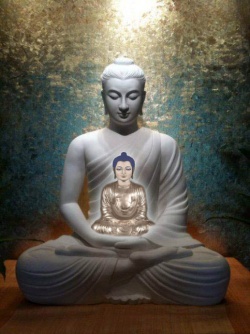Difference between revisions of "Sanghyang Kamahayanikan"
(Created page with " Sanghyang Kamahayanikan; Sang Hyang Kamahayanikan; is a prose {{Wiki|literature}} of old Javanese people. The back side of this {{Wiki|literature}} contain a ...") |
|||
| (2 intermediate revisions by the same user not shown) | |||
| Line 1: | Line 1: | ||
| − | + | [[File:100150hjkk.jpg|thumb|250px|]] | |
| − | [[ | ||
| − | In his {{Wiki|dissertation}}, Dr. Noehardi Magetsari (2000) mentioned that the structure of [[Borobudur]] actually show the developmental stages of a [[yogi]] [[experiences]] to achieve [[Buddhahood]] where [[feelings]] and [[thoughts]] stop. [[Borobudur's]] popular term of [[Kamadhatu]], [[Rupadhatu]], [[Arupadhatu]] are also contained in [[Sanghyang Kamahayanikan]] | + | |
| + | |||
| + | |||
| + | |||
| + | |||
| + | |||
| + | |||
| + | |||
| + | [[Sanghyang Kamahayanikan]]; [[Sang Hyang Kamahayanikan]]; is a prose {{Wiki|literature}} of old [[Javanese]] [[people]]. The back side of this {{Wiki|literature}} contain a [[name]] of [[Javanese]] [[king]], i.e. [[Mpu Sindok]], which is throned at [[East]] {{Wiki|Java}} from 929 to 947 C. | ||
| + | |||
| + | In his {{Wiki|dissertation}}, Dr. Noehardi Magetsari (2000) mentioned that the {{Wiki|structure}} of [[Borobudur]] actually show the developmental stages of a [[yogi]] [[experiences]] to achieve [[Buddhahood]] where [[feelings]] and [[thoughts]] stop. [[Borobudur's]] popular term of [[Kamadhatu]], [[Rupadhatu]], [[Arupadhatu]] are also contained in [[Sanghyang Kamahayanikan]] | ||
History | History | ||
| − | It was written about 929-947 C by [[Mpu Shri Sambhara Surya Warama]] from [[East]] {{Wiki|Java}}, the successor of {{Wiki|Mataram Kingdom}} which was shifted to [[East]] [[Java]]. The oldest {{Wiki|literature}} was found on {{Wiki|Lombok}} Island in 1900 C. {{Wiki|Professor}} Yunboll discussed it on 1908 and was translated into Dutch [[language]] by J.deKatt in 1940' later it was inspected by {{Wiki|Professor}} Wuff. This {{Wiki|literature}} was translated into [[Wikipedia:Indonesian language|Indonesia language]] by I Gusti Bagus Sugriwa. Last translation process is done by "Translation Team of [[Buddhist Scriptures]] Ditura [[Buddha]], {{Wiki|Indonesian}} Ministry of [[Religious]] Affairs." | + | It was written about 929-947 C by [[Mpu Shri Sambhara Surya Warama]] from [[East]] {{Wiki|Java}}, the successor of {{Wiki|Mataram Kingdom}} which was shifted to [[East]] [[Java]]. The oldest {{Wiki|literature}} was found on {{Wiki|Lombok}} [[Island]] in 1900 C. {{Wiki|Professor}} Yunboll discussed it on 1908 and was translated into {{Wiki|Dutch}} [[language]] by J.deKatt in 1940' later it was inspected by {{Wiki|Professor}} Wuff. This {{Wiki|literature}} was translated into [[Wikipedia:Indonesian language|Indonesia language]] by I Gusti Bagus Sugriwa. Last translation process is done by "Translation Team of [[Buddhist Scriptures]] Ditura [[Buddha]], {{Wiki|Indonesian}} Ministry of [[Religious]] Affairs." |
Contents | Contents | ||
Latest revision as of 15:04, 27 December 2023
Sanghyang Kamahayanikan; Sang Hyang Kamahayanikan; is a prose literature of old Javanese people. The back side of this literature contain a name of Javanese king, i.e. Mpu Sindok, which is throned at East Java from 929 to 947 C.
In his dissertation, Dr. Noehardi Magetsari (2000) mentioned that the structure of Borobudur actually show the developmental stages of a yogi experiences to achieve Buddhahood where feelings and thoughts stop. Borobudur's popular term of Kamadhatu, Rupadhatu, Arupadhatu are also contained in Sanghyang Kamahayanikan
History
It was written about 929-947 C by Mpu Shri Sambhara Surya Warama from East Java, the successor of Mataram Kingdom which was shifted to East Java. The oldest literature was found on Lombok Island in 1900 C. Professor Yunboll discussed it on 1908 and was translated into Dutch language by J.deKatt in 1940' later it was inspected by Professor Wuff. This literature was translated into Indonesia language by I Gusti Bagus Sugriwa. Last translation process is done by "Translation Team of Buddhist Scriptures Ditura Buddha, Indonesian Ministry of Religious Affairs."
Contents
This literature contain Mahayana (especially Vajrayana) Buddhism teaching, mostly about the list of deities in Mahayana -which is often matched with the placement of the Buddhist kings in the Borobudur temple. The literature also contain the procedure of meditation.
According to dr. DK. Widya, Sanghyang Kamahayanikan teaches how can one attains Buddhahood, i.e. a student must first practice Pāramitā, then described Paramaguhya and Mahaguhya. As an addition, it also explained the philosophy of Adwaya that overcoming the dualism "existance" and "non-existance". In the book there is a very detailed description of how a tantric yogi prepare himself for spiritual path, from the start until the implementation of multilevel worships. It is said that the Vajrayana doctrines is meditation towards Five Tathagata. By worship them, a yogi can attain the purity of mind. Popular culture
Sang Hyang Kamahayanikan Award is award of Borobudur Writers & Cultural Festival for any individual or groups who have been responsible and has contributed greatly to the cultural and historical assessment Indonesian historians, writers, archaeologists, cultural, historical background author, playwright, puppeteer, clergy, philologist, and so on.
